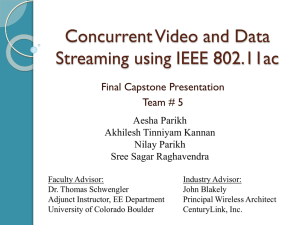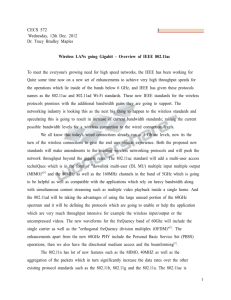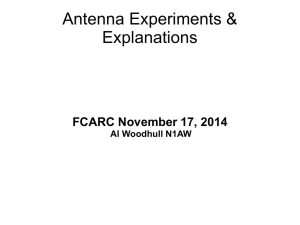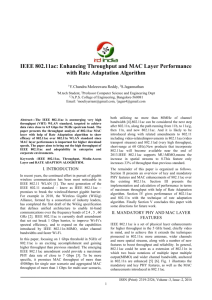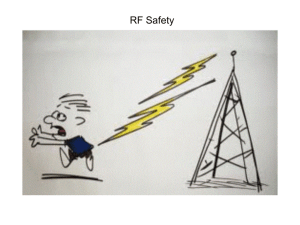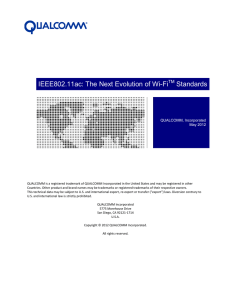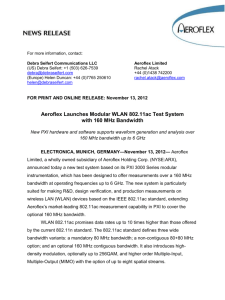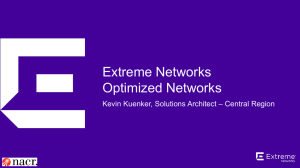11ac: 5G WiFi - IEEE ComSoc SCV
advertisement
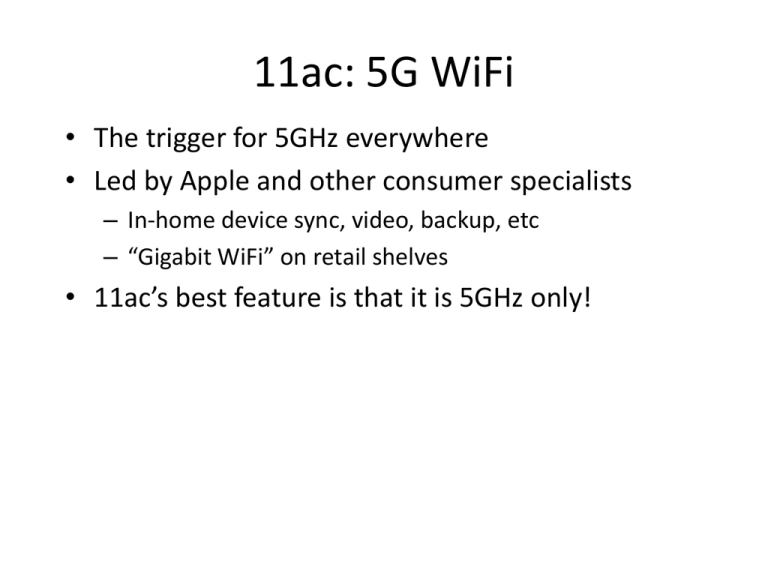
11ac: 5G WiFi • The trigger for 5GHz everywhere • Led by Apple and other consumer specialists – In-home device sync, video, backup, etc – “Gigabit WiFi” on retail shelves • 11ac’s best feature is that it is 5GHz only! 11ac Data Throughputs 11ac Potential Rates vs 11n QAM code bits rate PHY BW streams MAC eff. Mb/s TCP Mb/s 11n 1x1, 2.4 GHz max 6 0.833 20 1 0.65 75 49 11n 2x2, 5 GHz max 6 0.833 40 2 0.65 300 195 11n 3x3, 5 GHz max 6 0.833 40 3 0.65 450 293 11n best (4x4 5GHz) max 6 0.833 40 4 0.65 600 390 6 0.833 80 3 0.65 975 634 6 0.833 160 3 0.65 1950 1268 8 0.875 160 4 0.65 3640 2366 8 0.875 160 8 0.65 7280 4732 11ac 3x3, 80 MHz, 64QAM, max 11ac 3x3, 160 MHz, 64QAM, max 11ac 4x4, 160MHz, 256QAM, max 11ac maximum (8x8 etc.) 11ac Wave 1 • 80MHz channels • 256QAM modulation – Potentially could be added to 2.4GHz • MAC improvements • Ubiquitous support on TX-BF (hopefully) Wave 2 • MU-MIMO • 160MHz channels – non adjacent (future?) 11ac: wider channels • 80 MHz Channels 5735 MHz 5835 MHz 149 153 157 161 165 5710 MHz 100 104 108 112 116 120 124 128 132 136 140 IEEE channel # 20 MHz 5330 5490 MHz MHz 36 40 44 48 52 56 60 64 5170 MHz 40 MHz 80 MHz More spectrum coming soon 160 MHz (potentially noncontiguous) channels in ~2014? WLAN - 160 MHz Radar WLAN U-NII 1 WLAN U-NII 2 Radar 80 MHz WLAN U-NII Worldwide 80 MHz U-NII 3 J Dynamic bandwidth (BW) operation • Currently channel must be free on whole 40MHz even if using 20MHz only – Wider channel increases likelihood of interfering signal in extension – Dynamic BW capability is desired to utilize BW more efficiently – Not required, but most vendors support it Secondary 40MHz 36+40 Primary 20MHz Secondary 20MHz 44 48 Mode 1 Mode 2 Mode 3 • Meeting spectral mask is challenging • Operating mode change requires 10s of milliseconds 11ac: 256QAM QPSK 256QAM Bits/ Relative Modulation Symbols Sym. speedup BPSK QPSK 16QAM 64QAM 256QAM 6 2 4 16 64 256 1 2 4 6 8 2.00 2.00 1.50 1.33 11ac MAC Changes • • • • Frame size and MAC efficiency Dynamic bandwidth operation CCA thresholds differently handled New RTS/CTS rules MAC efficiency AIFS Random backoff Preamble/ PHY header MAC header Payload Overhead PSDU size (Bytes) 1500*32 Effective 450Mbps 1.3Gbps 2.6Gbps UDP Goodput (Mbps) MAC efficiency UDP Goodput (Mbps) MAC efficiency UDP Goodput (Mbps) MAC efficiency 347 77% 734 56.5% 1019 39.2% 80.5% 810 62% 1180 45.5% 1038 80% 2000 77.5% 64K (max 11n) 362 172K t 295K Note: BestEffort QoS is assumed 11ac strengthened Clear Channel Assessment (CCA) requirement • Must detect WiFi signals with energy level above threshold on all channel widths – Preamble detection not required • Different back-off thresholds for WiFi vs non-WiFi signals – Device must be either smart enough to differentiate WiFi signals vs other energy or use lowest threshold for all Energy Detection threshold (in dBm) for signals not occupying primary 20MHz channel 20MHz 40MHz 80MHz WiFi signal -72 -72 -69 Non-WiFi signal -62 -59 -56 RTS/CTS in 11ac • Under 11n RTS/CTS rules for wider channels, a responder responds with CTS using full wide channel • If a transmitter receives a CTS on 20MHz channel, it responds with data using full width channel (20/40/80MHz etc.) • This rule does not account for possible interference on the wider channels Primary RTS CTS BA Secondary20 RTS CTS BA RTS CTS BA RTS CTS BA Secondary40 SIFS Interference at responder time time time time Wave 2 – Multi-User (MU-MIMO) 11ac : DL-MU-MIMO 2 streams 1 stream Phone 1 stream Phone PC AP 2 streams PC • Down-link Multi-User MIMO (spatial division multiple access) • Makes use of multiple physical paths through the environment to enable multiple simultaneous transmissions to different receivers • Impressive capacity improvements if you can fit 8-16 antennas per band on an AP. 12 DL-MU: basic parameters • Max. # of users per packet • Max. # of space-time streams per user :4 :4 – Collision free maximum # of space-time streams for SU packet = 8 • Max. total # of space-time streams over all users: 8 DL-MU – Spatial Multiplexing Single-User MIMO (11n) Stream 1 Stream 2 Stream 3 Stream 4 Multi-User MIMO (11ac) Stream 3 • Historically – Access points and clients were using same/similar baseband • MU requires different designs – AP complexity increased due to MU support in both HW and SW – MU capability costs likely to push market to different AP and client BB 14 silicon DL-MU: Sequential Block ACK • Sequential Ack is used because no UL-MU support • One user send immediate BA • Other users are polled using BAR STA 1 AP STA 2 BAR BAR STA 3 SIFS STA 1 SIFS BA SIFS PIFS 15 SIFS BA STA 2 STA 3 SIFS Error Recovery (same for sounding) BA DL-MU: TXOP sharing • After random back off the winning AC will be allowed to transmit • Other ACs are allowed to piggy back in MU packet as long as it doesn’t extend the TXOP – If primary AC is voice, max TXOP is 1.5 seconds – If primary AC is video, max TXOP is 3 seconds Video Voice (primary AC) Data Thank You
